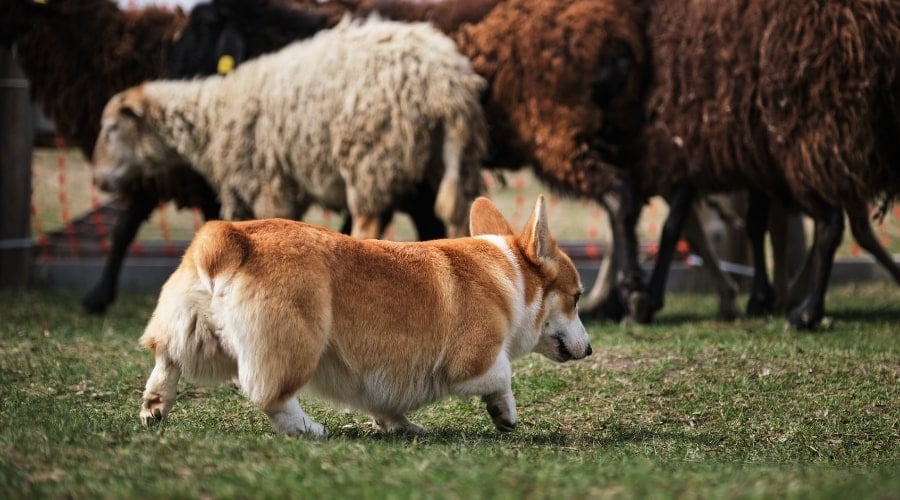When you purchase through links on our site, we may earn a commission. Here’s how it works.
Some puppies never wag their tails because they lose them just days after birth. Not from injury. Not from illness. From a pair of scissors. It’s called dog tail docking, and it still happens all over the world – even though most people have no idea what it really involves.
Table of Contents
Some breeders say it’s tradition. Vets call it unnecessary. But what’s the truth behind this old-school practice, and why hasn’t it disappeared? Let’s start with the moment it happens – when puppies are barely a week old.

Why Are Puppies’ Tails Docked So Young?
It happens fast, usually before a puppy even opens their eyes. Just three to five days old.
At that age, their tails are tiny, soft, and still full of nerves. Breeders call it “routine.” But the truth? It’s a surgical amputation.
No anesthesia. No pain relief. Just a quick snip or a rubber band tied tight until the tail dies and falls off.
The idea is that puppies “won’t remember.” But nerves don’t care about memory. They feel pain and react just like any other baby animal would – with crying, twitching, and distress.
So why do it at all? That’s where things start to get complicated… and controversial.

It happens before a puppy can even wag, but the reasons behind it go way further back than you’d think.
Dog Tail Docking History
Tail docking isn’t new; it’s ancient. The first records date back to the Romans, who believed that cutting a dog’s tail would prevent rabies. (Spoiler: it didn’t.)
A few centuries later, farmers started docking to stop herding dogs from getting injured in the fields. That made sense back then, given the rough terrain, lack of vet care, and significant risk.
But here’s where it took a strange turn… As dogs became show animals instead of workers, breeders kept docking tails simply because it “looked right.”
Some kennel clubs even made it part of the official breed standard, meaning dogs with full tails couldn’t compete or be heavily penalized. So, an outdated farm habit evolved into a cosmetic tradition that stuck long after its original purpose had disappeared.
Today, many vets call it what it is: an unnecessary surgery done for looks, not health. But it’s still happening, mostly because “that’s how the breed has always looked.”
What began as superstition turned into tradition, and somehow, it’s still shaping how breeders judge dogs today.
The Real Reasons Behind Dog Tail Docking
So, why do people still do it?
For some, it’s all about appearance – keeping that “classic” breed look. Breeders say a docked tail completes the silhouette. Dog show judges have expected it for decades, especially in breeds like Dobermans, Boxers, and Schnauzers.
But that’s only part of the story.

Tail docking started as a way to prevent injuries in hunting and working dogs – those sprinting through brush or herding livestock. The idea was that a shorter tail meant less risk of cuts or infections.
But here’s the catch: most of today’s dogs aren’t chasing cattle or pheasants. They’re chasing tennis balls.
Even so, the habit stuck, passed down from “breed standards” and tradition rather than need. Some still argue it prevents tail damage or keeps long-haired dogs cleaner, but vets say there’s little scientific evidence to back that up.
In truth, tail docking has become a cosmetic choice, not a medical one, and a leftover from the past that keeps getting justified in new ways.
Modern Breed Standards That Still Require Tail Docking
Even today, several parent breed clubs still have show standards that call for docked tails. Here are a few examples:
- Doberman Pinscher: Tail must be docked approximately at the second joint.
- German Shorthaired Pointer: Tail must be docked, leaving approximately 40% of its length.
- Boxer: Tail is expected to be docked close to the body.
- Miniature Schnauzer: Tail should be docked so it is long enough to be clearly visible over the backline of the body.
Although undocked tails are not disqualified from competitions, most breed standards state that any dog with an undocked tail should be severely penalized in the ring.
These official standards show that tail docking isn’t just an old custom, and it’s still written into modern dog show rules, keeping cosmetic cuts alive in today’s breeding world.
But knowing why it happens is only half the story; the next part shows how.
How Dog Tail Docking Actually Happens (Brace Yourself)
It sounds simple, a quick snip and done. But here’s what really happens…
Tail docking is usually done when puppies are just 3–5 days old – before their eyes open, before they can even stand. Most breeders don’t use anesthesia, claiming “they won’t remember.” But nerves still work, and pain still hurts.
There are two main ways it’s done:
- Cutting: the tail is severed with scissors or a scalpel, slicing through muscle, bone, and nerve tissue.
- Banding: A tight rubber band is placed around the tail until it dies and falls off days later.
Veterinary surgeons typically don’t use sutures with this procedure, but they may be necessary for larger dogs or if the dog is experiencing excessive bleeding.
Neither method is painless, and neither is medically necessary for most breeds. The American Veterinary Medical Association (AVMA) strongly discourages it, referring to it as a cosmetic surgery without benefit.
But the real damage isn’t just physical; it changes how dogs express emotion, too.
Can Dogs Still Communicate Without Their Tails?
A wag isn’t just cute, it’s body language.
Dogs use their tails to talk, to tell us when they’re happy, nervous, curious, or scared. That gentle sweep when you walk in the door? That’s “I missed you.” A tucked tail? “I’m worried.”
Now imagine trying to speak without your voice. That’s what a docked dog deals with every day.
Without a full tail, their body language gets harder for other dogs (and even humans) to read. Some dog experts say this can cause social confusion, because a docked dog might be misunderstood as aggressive or anxious when they’re just excited.

It’s not just emotional, either. Tails help dogs balance, turn, and even steer while running or jumping. So, docking doesn’t only silence part of their language. It can also affect how they move.
They may not complain, but every tail wag they can’t make is a message lost.
And that’s not the only hidden cost. Tail docking can cause lasting pain that most owners never see.
Health Risks & Hidden Pain: What Vets Want You to Know
You might think tail docking is a quick cut and done. But the pain doesn’t always end when the scissors stop.
Veterinarians warn that docking can trigger lifelong complications, not just a bad few minutes as a puppy. The tail is packed with nerves, blood vessels, and muscles, and once it’s removed, those nerves can misfire forever.
Here’s what can happen:
- Neuromas: painful nerve tumors that make dogs yelp if their tail stump is touched.
- Infection: open wounds are easy targets for bacteria.
- Chronic pain: nerves never heal cleanly; some dogs stay sensitive for life.
- Surgical risk: in rare cases, blood loss or shock can be fatal.
Even docking done “by the book” can leave lasting pain that dogs can’t explain and only show through behavior. Some veterinarians report that dogs with docked tails flinch at tail contact or refuse to sit comfortably.

That’s why the AVMA, the British Veterinary Association (BVA), and countless others all oppose cosmetic tail docking. They agree: it’s unnecessary suffering for a purely aesthetic look.
A Survivor’s Story: Daisy’s Docked Tail
My dog Daisy, a Pitbull-Labrador mix, was rescued from the streets with a litter of puppies when she was six weeks old. When I met her at the shelter, she was pure joy, wiggly, bright-eyed, full of life. But one thing stopped me: her tail was partially docked. Every pup in her litter was the same.
When I asked why, the volunteer explained that illegal dogfighting had been common in our area. Litters like Daisy’s, part Pitbull, were often dumped when they weren’t “fit” for the ring. It broke my heart.
I brought Daisy home that day, and for nearly fourteen years, she’s been my loyal shadow. Her tail healed, but people still sometimes stop to ask why it’s so short. A few even make assumptions about her because of it. I always tell them the truth: she came to me that way… a survivor, not a fighter.
But Daisy doesn’t seem to notice. To her, every walk is a celebration, proof that she got her tail-wagging happy ending after all.
– Danielle DeGroot, Rescue Dog Mom & Writer for Canine Journal

If it’s this painful and risky, is there ever a good reason to do it?
Are There Any Legit Medical Reasons for Tail Docking?
Not every docked tail comes from vanity. In rare cases, medical tail amputation is necessary, but that’s not the same thing as cosmetic docking.
A vet might recommend partial tail removal only when:
- There’s severe trauma or a fracture that can’t heal properly.
- A dog has a chronic infection or tumor on the tail.
- The tail causes self-injury from obsessive chewing or injury.
These are legitimate medical treatments all done under anesthesia, for the dog’s comfort and safety, not for looks.
Veterinarians draw a clear line between therapeutic amputation and elective docking. One heals; the other harms.
So where do the experts stand? Most major vet associations have made their position loud and clear.
What Do Vets and Animal Welfare Groups Say?
Across the board, vets are saying the same thing: don’t dock tails unless it’s medically necessary.
The AVMA considers cosmetic tail docking to be painful and unjustified. The BVA agrees, stating that it causes unnecessary suffering and deprives dogs of an important form of expression.
Even major veterinary chains like Banfield Pet Hospital refuse to perform it entirely.
Animal welfare groups are equally firm. The RSPCA, ASPCA, and Humane Society all classify tail docking as an outdated practice with no proven benefit. Many European countries and all of the U.K. have banned it except for working-dog exemptions.

Meanwhile, in the U.S., parent breed clubs still allow, and even encourage, docked dogs to compete, keeping the practice alive in the show ring even as most vets push back.
The message from experts is clear: this isn’t about better breeding, it’s about outdated beauty standards that cause lasting harm.
But not every short tail is man-made; some dogs are born that way.
Bobbed vs. Docked: The Tale of Two Tails
Not every short tail is the result of docking. Some dogs are born with naturally bobbed tails, thanks to a genetic mutation, C189G, that shortens the tail before birth.
These “bobtail breeds” don’t go through surgery at all. Their tails just grow shorter, often wagging like little stubs from day one. Breeds like Australian Shepherds, Pembroke Welsh Corgis, and Brittany Spaniels are classic examples.

Docked tails, on the other hand, are surgically altered after birth and cut or banded by humans. The difference may look subtle, but it’s huge for the dog.
A bobbed tail has full sensation and natural muscle control. A docked tail may have scar tissue, nerve pain, or stiffness that affects how it moves.
So if you see a short-tailed pup, remember: one tail was born that way, and one was taken away.
And tail docking isn’t the only cosmetic cut dogs endure; there’s another that’s just as controversial.
Tail Docking vs. Ear Cropping: The Other Controversial Cut
Tail docking isn’t the only cosmetic procedure dogs still face. Ear cropping, the surgical reshaping of a puppy’s ears, is another long-debated practice.
Both are done for looks, not health, and both are usually performed when dogs are only a few weeks old. The breeds are often the same, too, Dobermans and Boxers, because show standards once demanded both a short tail and pointed ears.

Most countries now ban ear cropping completely, while tail docking laws remain inconsistent.
Want to Learn More? If you’d like the full breakdown of how ear cropping works, its history, and where it’s legal, check out our companion guide: Dog Ear Cropping Explained.
Speaking of laws — how much of this is even legal today? You might be surprised.
Is Dog Tail Docking Legal Where You Live?
Whether tail docking is legal depends entirely on where you live, and the rules still vary wildly.
In the United States, there’s no federal law banning the practice. That means it’s mostly up to each state to decide. So far, only Maryland and Pennsylvania have clear, statewide laws that restrict when and how tail docking can be done.
- In Maryland, only licensed veterinarians can dock a tail if it’s appropriate, and they must use anesthesia.
- In Pennsylvania, docking a puppy’s tail is illegal if the puppy is more than five days old.
A few other states, like California, New York, and Colorado, have broader animal-welfare regulations that discourage or limit cosmetic procedures, but most don’t mention tail docking directly.

In most of the U.S., it remains largely unregulated, meaning breeders can still perform it as part of “breed tradition.”
Outside the U.S., the story’s very different. Across Europe, Australia, New Zealand, and much of Canada, cosmetic tail docking is banned outright except for verified medical reasons or specific working-dog exemptions.
In the U.K., even showing a docked dog at a public event is illegal unless it’s a certified working dog.
Does Pet Insurance Cover Tail Docking?
Pet insurance doesn’t cover tail docking for cosmetic purposes because it’s considered an elective and inhumane procedure. However, some pet insurance policies may cover tail amputation procedures (different from tail docking) if deemed medically necessary by your veterinarian.
Additionally, the condition in which your vet determines that tail amputation is necessary must be included in the coverage of your policy and not considered pre-existing.
Learn more about what pet insurance covers and our review of the best pet insurance.
Should Tail Docking Be Banned?
Tail docking sits in a strange space between tradition and controversy. Some breeders still defend it as “heritage.” Most vets call it an unnecessary surgery that puts looks before welfare.
Around the world, more and more countries are saying enough. The laws are catching up, and the science is clear – puppies feel pain, whether we choose to remember it or not.
But change often starts with awareness. Every time a dog owner asks questions, skips a “standard” cosmetic cut, or chooses to adopt instead, that’s a quiet vote against needless pain.
So where do you stand? Should tail docking be banned entirely, or kept for working dogs only? Let us know in the comments, share your thoughts, and let’s keep the conversation going – because tails were made to wag, not be cut short.
Frequently Asked Questions About Dog Tail Docking
Curious about tail docking laws, pain levels, or what experts really say? Here are some of the most common questions dog owners ask about this controversial practice.
If I missed something you’re wondering about, drop your question in the comments, because we’d love to help clear it up.

Why Do People Dock Dogs’ Tails?
Originally, tail docking was done to prevent injuries in working dogs or to follow breed traditions. Today, most docking is cosmetic, usually done to meet outdated “breed standards” in show dogs, not for health reasons.
Does Tail Docking Hurt Puppies?
Yes. Puppies may be only a few days old, but their nerve endings are active and sensitive. Studies show they feel pain and distress during and after the procedure, even when it’s done quickly.
Is Dog Tail Docking Ever Medically Necessary?
Rarely. A veterinarian might perform a therapeutic tail amputation for serious injury, chronic infection, or cancer, but that’s different from cosmetic docking. It’s done under anesthesia and only to protect the dog’s health.
Is Tail Docking Legal in the United States?
There’s no federal ban, and only two states, Maryland and Pennsylvania, have clear laws regulating when and how it can be done. In most states, the practice remains legal or loosely regulated, especially for breeders.
What Countries Have Banned Tail Docking?
Most of Europe, along with Australia, New Zealand, and much of Canada, has banned cosmetic tail docking entirely. The U.K. only allows it for certified working dogs, and showing docked dogs at public events is restricted.
Can Dogs Still Communicate Without Their Tails?
They try, but a tail is a major part of how dogs express emotion. Without it, other dogs (and even humans) may misread their signals, causing confusion or tension. A full tail helps them “speak” through movement and balance.
Should Tail Docking Be Banned?
Most veterinarians and animal welfare experts say yes. It causes unnecessary pain, offers no proven health benefit, and removes an important part of how dogs communicate and move.
Love Your Dog the Way They Deserve
Start by nourishing them from the inside out with the best fresh dog food that uses real, whole ingredients to keep them thriving. Keep their tail wagging and their mind sharp with our picks for the best interactive dog toys, perfect for smart pups who need fun challenges.
When it’s time to rest, nothing says comfort like the best orthopedic dog beds, designed to protect joints and support deep, cozy sleep.
And if you want to strengthen your bond even more, our guide on how to show your dog you love them is full of simple, heartwarming ways to remind your best friend they’re perfect just the way they are.
Share Your Story or Opinion! Have you owned a dog with a docked tail or chosen to keep your pup’s tail natural? We’d love to hear what shaped your decision. Share your experience and thoughts in the comments.




